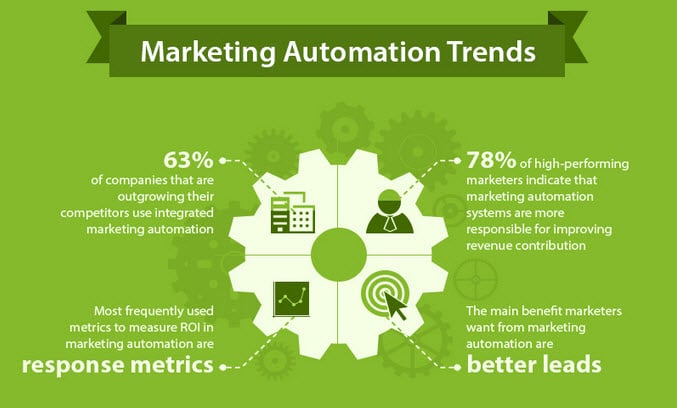Productivity!”
The battle cry and name for God on the lips and hearts of our government as they exhort companies to “automate, drive productivity, and scale up”, according to Finance Minister Heng Swee Keat in his 2016 Budget Speech[1].
You know what – we believe in it. Companies that automate are simply more productive.
But what does it mean for marketers?
Easy. Automate your marketing.
How Should Marketers Automate Their Marketing?
See the name of our blog.
Put simply, Marketing Automation refers to “software platforms and technologies designed for marketing departments and organisations to more effectively market on multiple channels online (such as email, social media, websites, etc.) and automate repetitive tasks.”[2] (Emphasis mine). It’s often accompanied by a set of content-led activities (e.g. blog posts, downloadable eBooks, social media sharing, and blog engagement etc) that bring in visitors.
Conceptually, it’s great. Buy a piece of software, decide on your content and activities, and let it automate your marketing. In truth, it is far more complex and full of moving parts. And, as with any new tactic, there will be resistance to chance.
So how do you get it going? The rest of this post outlines common objections and answers.
1) I Need to Show ROI Now!
What drives it: Fear. You’re tasked to show results within 6 months.
Answer: Buy more time with your bosses. Use proof points.
Honestly, Marketing Automation does take time. Based on our past campaigns, we find that they take about 3+ months before we see any results. When dealing with impatient bosses, it helps to break down Marketing Automation projects into phases – planning, development, delivery and engagement, and reporting – to highlight the amount of time for each phase. At the same time, we also highlight the effectiveness of Marketing Automation (such as increase in sales productivity and reduction in marketing overheads) for stakeholders to give you more time. Check out Wishpond’s blog post on the 2015 state of Marketing Automation for great stats to use.

2) Why Change What Works?
What drives it: Resistance to change from bosses.
Answer: Reassure, show proof points, and examples.
Build your argument with proof points and stats (oh lies and damn stats!) on Marketing Automation effectiveness. We quite like this list of stats from Business 2 Community and Hubspot (disclaimer: we are Hubspot partners). The infographic help start the conversation for you.
An example argument could go: “On average, studies show that inbound marketing cost 60% less than outbound marketing for the acquisition of one new lead. An efficient inbound marketing is a salesman who is as good as you, without time or space limits, and without additional cost.”

3) It Looks Complicated!
What drives it: Overwhelmed by Marketing Automation
Answer: Break down the software into its component parts. Work on one part before incorporating it into the rest.
Set up simple lead nurturing campaigns to learn the platform and give customers value. An example would be monthly emails on your promotions or blog posts or offers. Once you get it, move on to other parts such as creating landing pages and lead scoring. Repeat for the other components. Eventually you’ll get better and, more importantly, faster at creating campaigns on your Marketing Automation Platform.
4) I Don’t Have Staff or Resources for This!
What drives it: Need for new expertise and skills
Answer: Start slowly. Test your comfort level.
Don’t do everything at once. Just get started.
Instead of doing one blog post everyday, do one every week. Instead of running one campaign every month, do it every quarter. This helps you get a sense of the amount of work, what’s involved in it, and it also helps to get you comfortable with Inbound Marketing.
If you need help figuring out how to get started with Marketing Automation, drop us an email and we’ll be happy to help you out where possible.
5) Social Marketing (and Inbound Strategies) Aren’t for My Clients!
What drives it: Mistaken beliefs.
Answer: Research and research.
Instinctively that seems correct – particularly for B2B marketers. But realistically, that is a fallacy. According to Think With Google, 46% of B2B marketers are Millennials (18 to 34 years old)[3]. A surprising fact that has implications on where you’ll need to be at (hint: Starts with F and ends with K). We’re pretty sure that salespeople are already using social media to sell and connect with prospects.
So, there you have it. 5 common objections with 5 hopefully helpful answers. How do you get Marketing Automation going in your company?
Like what you read? Subscribe to our B2B Marketing Posts for more good stuff!
Image Credits & Sources
Header image from Luis Llerena @ Stocksnap.io
Marketing automation stats image from Forbes
[1] Automation Support Package: What you need to know (src: Channel News Asia)
[2] Marketing Automation (src: Wikipedia)
[3] The Changing Face of B2B Marketing (src: think with Google)